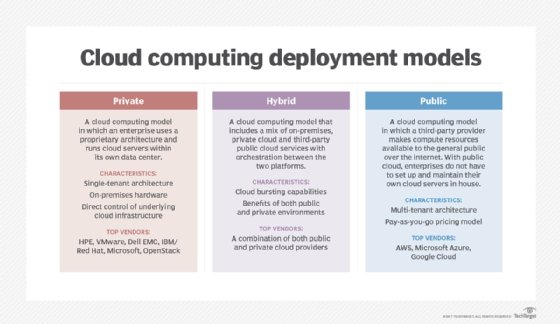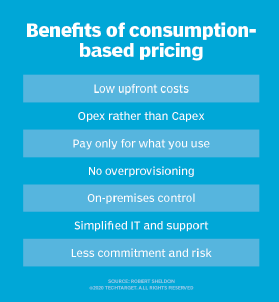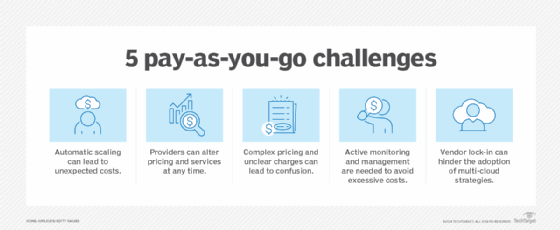What are metered services and how do they work?
Metered services (also called pay-per-use and consumption-based pricing) are any type of payment structure in which a customer has access to potentially unlimited resources but only pays for what they use. Metered services are becoming increasingly common in enterprise IT environments, particularly in the areas of cloud computing and SaaS. Metered services are also common in telecommunications.
How do metered services work?
A metered service refers to a pricing model whereby a customer is provided with a service and charged for the amount of the service used. To ensure correct billing, the service provider must have metering capabilities, i.e., the ability to measure the amount of service provided to and consumed by the customer, whether it's electricity, water, gas, cloud resources or something else, during each billing cycle. The meter captures detailed information about the customer and their usage of the particular service. Providers must be able to analyze the collected data to generate accurate and detailed invoices for the customer.
Many customer organizations prefer to use metered services because they get full visibility into the amount of the service consumed and know that they are only paying for what they consumed. Another common name for metered pricing is pay-as-you-go (PAYG) pricing. Metered services also allow organizations to get better control over their spending.
Examples of metered services
The telecommunications and computing industries provide the best examples of metered services; for example, SaaS software providers and cloud service providers (CSPs) commonly offer metered services.
Consider utility computing, which enables a company to purchase computing resources to match fluctuating needs. The provider only charges for the resources customers use. If the customer needs more computing resources like processing power or memory due to a surge in demand, the provider adds additional resources and adjusts the billing at the end of the billing cycle. Likewise, if the demand for resources falls, the provider adjusts the services and pricing accordingly. For organizations, utility can be more cost-effective than maintaining a large infrastructure that exceeds the company's average computing power requirements.
Phone companies -- both traditional and mobile -- have offered metered billing for decades. Per this model, customers are charged based on the number of minutes they use the service, the number of texts and the amount of data consumed. The provider measures a consumer's per unit usage of the cellular service and charges them accordingly and usually per fixed period (e.g., monthly). Incoming texts and phone calls are usually not charged by most cellular companies, although this is not always the case.
Metered billing is also gaining popularity in the consumer internet market. While most internet service providers (ISPs) charge a flat monthly or yearly subscription fee, some ISPs also offer pricing models based on actual usage.
A growing number of entertainment websites and streaming services also use a PAYG structure. Apple's iTunes, for instance, allows users to sample music files for free, but charges the user a small fee for a complete download of any given song.
Other examples of metered usage cloud pricing include IaaS, PaaS and SaaS cloud services. These services are available from many public cloud providers, notably AWS, Microsoft Azure and Google Cloud Platform (GCP).

Benefits of metered services
The biggest benefit of metered or PAYG services is cost effectiveness. Customers who use less than the average amount of a service and customers whose usage tends to fluctuate due to various factors (seasonality, spikes or troughs in customer demands, etc.) can gain substantial savings from metered billing. Moreover, they can get details about spending from the provider, and use this information make better decisions about future spending. This allows them to get better control over expenses.

Another benefit of metered services is transparency, since the provider only charges customers for the resources and features they use. The promise of transparency and fairness can improve the relationship between the provider and the customer.
Since metered connections allow providers to capture key customer insights that enable them to better understand the customer's needs, they may offer more tailored support to that customer. Providers can also use customer insights to improve their services, which can further strengthen the relationship with that customer and lead to a higher customer lifetime value.
Drawbacks of metered services
The metered service model can be complex to implement for small service providers since it requires them to have metering and analytical capabilities. Also, customers who are used to traditional flat-rate licensing models may find it hard to understand the PAYG model. Due to this lack of understanding, they may not fully appreciate the model's transparency or cost-saving potential. As a result, they may be quicker to switch to a provider that seemingly offers a cheaper alternative. Clear service level agreements (SLAs) and detailed contracts can help to minimize customer confusion, which can then reduce customer churn and engender customer trust in the provider.
Some providers limit the services or features available under PAYG billing. This can be a drawback for organizations that need those services but are unwilling (or unable) to commit to long-term contracts or flat-rate pricing.

Metered services vs. flat-rate services
A flat-rate service refers to a service in which every customer is charged the same amount for using the service, regardless of actual usage.
Consider an internet service provider. ISPs measure customers' internet usage based on the amount of data transferred between the customer's device and the internet over a specific period of time. Usage is measured in data units like megabytes or gigabytes.
With a flat-rate plan, subscribers who use a little data or a lot of data end up paying the same amount. Thus, a subscriber who streams a movie, plays online games, or frequently downloads large software applications will pay the same as a subscriber who only logs onto the internet to check email or download cat photos from Google.
In contrast, a metered plan measures how much data each subscriber consumes, which determines their monthly bill amount.
Considerations for choosing metered services
The following are a few key considerations to weigh when choosing a service that provides a PAYG subscription model or metered services:
- How frequently do usage patterns fluctuate? If service usage fluctuates frequently, a metered pricing model provides greater flexibility and control, and therefore may be more appropriate. However, if usage is consistently high, then it may be more cost-effective for a firm to opt for flat pricing.
- Does the service offer higher pricing tiers? It's important to calculate typical total usage metrics over several billing cycles to determine whether metering services will result in cost savings. In some cases, it may be better to upgrade a base plan to a premium plan in order to save money.
- Can the provider quickly provision additional services as needed by the customer? If the provider is not capable of quickly provisioning additional bandwidth as needed to accommodate a CPU resource fluctuation, than a metered billing model would be more cost-effective than risking downtime due to a server outage.
Examples of PAYG offerings for IT hardware and cloud computing
AWS, Microsoft Azure and GCP are popular CSPs offering metered cloud services. Consumption-based, pay-per-use models have also gained traction as a payment method for IT hardware over the last several years. Here are some examples of products and companies that offer PAYG models for hardware:
Dell Technologies On Demand
Dell offers numerous consumption-based and as-as-a-service models throughout its infrastructure portfolio. One of these models is called Dell Apex Flex On Demand, a flexible model in which organizations get access to ready IT solutions and services, including storage and compute with payments that adjust (up or down) to match usage.
Hewlett Packard Enterprise GreenLake
HPE GreenLake is a set of IaaS tools that organizations can use on a pay-per-use basis. Through the GreenLake platform, users can access scalable, on-demand computing power to manage their IT infrastructure, while retaining control over their data and IT costs.
Lenovo TruScale Infrastructure Services
Lenovo TruScale includes both device as a service and IaaS. Through these PAYG models, organizations can access a range of digital workplace solutions and data center hardware to match their specific requirements. They can also scale up the solutions for their unique workloads without having to make large capital investments.
NetApp Keystone
NetApp Keystone is a PAYG, subscription-based service model for NetApp's data storage offering storage as a service (STaaS). With Keystone's simple operating model, SLA-based service tiers and predictable billing, customers can manage unpredictable capacity growth and meet workload requirements without having to concern themselves with capital expenditures, leasing or asset ownership.
Pure Storage Evergreen
Evergreen//One from Pure Storage is an SLA-driven STaaS offering that provides PAYG cloud storage with an all-flash, sustainable infrastructure. This model offers organizations the flexibility of the cloud plus a non-disruptive architecture that ensures highly reliable data storage, mobilization and protection.
Cloud computing is the ideal platform for building and deploying modern applications. Discover its key characteristics, including scalability, flexibility, multi-tenant architecture and on-demand resource access. See how the pay-per-use pricing model can boost digital initiatives.






